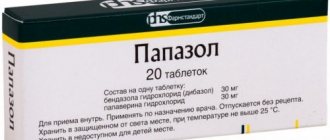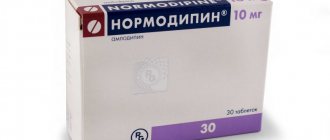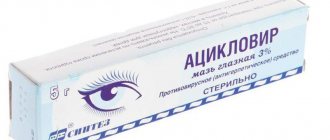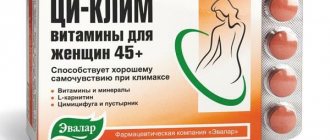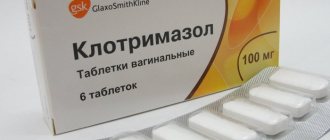Prohibited during pregnancy
Prohibited during breastfeeding
Has restrictions for children
Has restrictions for older people
Has limitations for liver problems
Has limitations for kidney problems
Taking anticonvulsants is the most common way to combat epilepsy attacks. Pagluferal is a complex medication used to relieve or prevent seizures. Used in neurology to treat epileptic seizures. There are three types of this medicine, which differ in dosage.
For example, Pagluferal 1 and Pagluferal 2 contain 25 and 35 mg of the anticonvulsant phenobarbital, respectively, and Pagluferal 3 –50 mg, and also contains a larger number of other active components. Due to the variety of dosage forms of the drug, it is important to understand which one should be chosen in a particular situation.
Release form and composition
The dosage form of the drug Pagluferal-1 is tablets: white, in the middle with a chamfer and a score (in a cardboard pack there are 2 contour strip packs of 10 tablets each or 1 dark glass jar containing 40 tablets).
Active ingredients in 1 tablet:
- brominated – 0.1 g;
- phenobarbital – 0.025 g;
- caffeine sodium benzoate – 0.007 5 g;
- calcium gluconate – 0.25 g;
- papaverine hydrochloride – 0.015 g.
Additional components: potato starch, calcium stearate.
Indications and restrictions
The indication for the use of Pagluferal is a chronic disease of the nervous system - epilepsy. Taking this medication is strictly prohibited if you have the following contraindications:
- dysfunction of the liver and kidneys;
addiction;- myasthenia gravis;
- dyskinesia;
- porphyrin disease;
- anemia;
- thyrotoxicosis;
- adrenal hypofunction;
- depression;
- chronic obstructive pulmonary disease;
- alcohol addiction;
- increased sensitivity of the body to individual components of the drug.
It should also be noted that the drug should not be used during pregnancy and lactation.
For some diseases, Pagluferal should be taken with caution. Such diseases include:
- mild form of hypercalcemia;
- reduced glomerular filtration;
- previous kidney stone disease.
If these diseases are present, during therapy with Pagluferal it is necessary to regularly check the level of calcium concentration in the urine. During the treatment period, it is not recommended to perform work that requires increased attention and instant reaction (for example, driving a car). The consumption of alcohol in any form is also prohibited.
Pagluferal 1 and 2 can be taken by children from the age of three, Pagluferal 3 from 7 years of age. It is necessary to take into account the permissible doses of the drug for children of each age group.
Pharmacological properties
Pharmacodynamics
Pagluferal-1 is one of the antiepileptic combination drugs.
The effect of the drug is due to the properties of the active substances included in its composition:
- papaverine hydrochloride: has an antispasmodic and hypotensive effect, helps relax smooth muscles and reduce the tone of internal vessels and organs;
- phenobarbital: has anticonvulsant, sedative, hypnotic and antispasmodic effects. Interacts with the barbiturate site of the benzodiazepine-GABA receptor complex. Due to this, the sensitivity of GABA receptors to GABA (gamma-aminobutyric acid) increases, which causes the opening of neuronal channels for chlorine ions and leads to an increase in their entry into cells. When using phenobarbital, the development of the following effects is observed: suppression of sensory zones of the cerebral cortex, decreased excitability of neurons of the epileptogenic focus, decreased propagation of nerve impulses, manifestation of antagonism in relation to some excitatory mediators (glutamate, etc.), decreased tone of the smooth muscles of the gastrointestinal tract, inhibition cerebral functions (including the respiratory center), decreased motor activity;
- calcium gluconate: helps replenish the deficiency of calcium ions, which take part in the processes of transmission of nerve impulses;
- Bromizolated: has moderate hypnotic and sedative properties;
- caffeine: promotes stimulation of the vasomotor and respiratory centers, increased reflex excitability of the spinal cord, activation of metabolic processes in organs and tissues, including the central nervous system and muscle tissues.
Pharmacokinetics
Caffeine
Caffeine is well absorbed throughout the intestine. The time to reach Cmax (maximum concentration of the substance) in the blood plasma is in the range of 50–75 minutes. It is characterized by rapid distribution in all tissues and organs and penetration through the blood-brain barrier and placenta. Communication with blood proteins (albumin) – from 25 to 36%.
Metabolism occurs in the liver (more than 90% of caffeine, in children of the first years of life - up to 10–15%). Approximately 4%, 10% and 80% of the substance in adults are metabolized to theophylline, theobromine and paraxanthine, respectively. Subsequently, they are demethylated into monomethylxanthines, then into methylated uric acids. T1/2 (half-life) in adults is 3.9–5.3 hours (sometimes up to 10 hours). Caffeine and its metabolites are excreted by the kidneys.
Phenobarbital
Absorbed slowly and completely. Cmax in blood plasma is achieved in 60–120 minutes, binding to plasma proteins is approximately 50%. The metabolic process occurs in the liver and induces microsomal liver enzymes CYP3A4, CYP3A5, CYP3A7 (an increase in the rate of enzymatic reactions by approximately 10–12 times is observed). Cumulates in the body. T1/2 – in the range of 48–96 hours. Excreted in the form of glucuronide by the kidneys, unchanged - about 25%. Penetrates through the placental barrier and into breast milk.
Calcium gluconate
From 1/5 to 1/3 of the dose is absorbed in the small intestine. Approximately 80% of the dose is removed with the contents of the intestine (the most active process occurs in the wall of the terminal part of the gastrointestinal tract), the rest is excreted by the kidneys.
Papaverine
The bioavailability of papaverine is on average 54%. Plasma protein binding is approximately 90%. It is well distributed and penetrates histohematic barriers. The metabolic process occurs in the liver. T1/2 – from 30 to 120 minutes (significant extension possible). Excreted by the kidneys in the form of metabolites.
Analogs
Possible substitutes and analogues of Pagluferal: Difenin, Carbamazepine, Zeptol, Konvulex, Benzoal, Briviac.
Toreal
Lecco (RF)
Price: 25 mg (28 tablets) – 179 rubles, 100 mg (28 tablets) – 455 rubles.
Antiepileptic drugs based on topiramate. Developed for the treatment of partial or generalized tonic-clonic seizures in adults and children, elimination and prevention of migraine (in adults).
The drug is available in the form of coated tablets.
The method of administration and dosage are determined individually.
Pros:
- Helps against migraine attacks
- Eliminates seizures
- Can be given to children from 2 years old.
Flaws:
- Mood swings
- Adverse reactions.
Contraindications
- broncho-obstructive diseases;
- adrenal hypofunction;
- porphyria;
- severe anemia;
- hyperthyroidism;
- severe renal/liver failure;
- depression;
- drug dependence (including aggravated medical history);
- myasthenia gravis;
- active alcoholism;
- diabetes;
- hyperkinesis;
- age up to 3 years;
- pregnancy and lactation;
- individual intolerance to the components included in the drug.
In weakened patients during treatment with Pagluferal-1, medical monitoring of the condition is required, since even with therapy in normal doses there is an increased risk of paradoxical agitation, depression and confusion.
Mode of application
Price (rub.) – 107 rub.
All forms of Pagluferal are recommended to be taken with meals. The dosage regimen and duration of therapy are determined by the treating specialist.
Pagluferal-1
For children:
- 3-4 years: 1 table. x 2 rub. in a day
- 5-6 years: 1.5 tablets. x 2 rub. in a day
- 7-9 years: 2 tables. x 2 rub. in a day
- 10-14 years: 3 tables. x 2 rub. in a day.
Teenagers (from 14 years old), adults: 4 tablets. x 2 rub. in a day.
Treatment regimens for Pagluferal-2, according to the instructions for use:
Children:
- (3-4 years): 1 table. x 2 rubles/d.
- (5-6 l.): 1.5 tablets. x 2 rubles/d.
- (7-9 l.): 2 tables. x 2 rubles/d.
- (10-14 l.): 2.5 tablets. x 2 rubles/d.
Teenagers (14+), adults: 4 tables. x 2 rubles/d.
Recommended dosage regimen for Pagluferal-3, given in the instructions for use:
Children:
- From 7 to 9 years: 1 tablet. twice a day
- From 10 to 14 years: 1.5 tablets. 2 twice a day.
Teenagers (14+), adults: 2 tablets each. twice a day.
During pregnancy and breastfeeding
Pagluferal should not be taken during pregnancy.
Breastfeeding women should abstain from lactation for the period of therapy. Since the drug contains substances that can pass into breast milk, the effect of Pagluferal can be extremely dangerous for newborns.
Side effects
- nervous system: general weakness, paradoxical reaction, ataxia, dysarthria, dizziness, sleep disturbances, nystagmus, hallucinations;
- cardiovascular system: atrioventricular block, tachycardia, increase/decrease in blood pressure, arrhythmia (including extrasystole);
- hematopoietic system: agranulocytosis, megaloblastic anemia, thrombocytopenia;
- gastrointestinal tract: increased activity of liver transaminases, nausea, vomiting, diarrhea/constipation;
- other: allergic reactions; with a long course of use - drug dependence.
Pagluferal 1
Active substance:
Bromisoval*, Calcium gluconate, Caffeine, Papaverine, Phenobarbital*
Pharmgroup:
Antiepileptic drugs in combinations
Average price in pharmacies
| Name | Manufacturer | average price |
| Pagluferal-1 n20 tab | MOSCOW PHARM. FACTORY | 78.00 |
| Pagluferal-2 n20 tab | MOSCOW PHARM. FACTORY | 96.00 |
| Pagluferal-3 n20 tab | MOSCOW PHARM. FACTORY | 124.00 |
Analogs for the active substance:Pagluferal 2 Pagluferal 3 |
special instructions
You should not drink alcohol during therapy.
Against the background of slight hypercalciuria, decreased glomerular filtration, and a history of nephrolithiasis during therapy with Pagluferal-1, it is necessary to monitor the calcium content in the urine (due to the presence of calcium gluconate in the drug).
Impact on the ability to drive vehicles and complex mechanisms
During the period of therapy with Pagluferal-1, patients should refrain from driving vehicles.
Similar means
The drug has no analogues with a similar composition, so you cannot replace it yourself. If it is necessary to change the drug, the doctor may prescribe medications with a similar anticonvulsant effect. Below is a list of the most effective ones:
Toreal is an antiepileptic drug that contains the active substance topiramate. This drug is also used to prevent migraine attacks. Children from two years of age can take the medicine.- Benzobamyl is a barbiturate, the action of which is also aimed at inhibiting the neurons of the epileptic focus. This medication is less common and is not always available in pharmacies.
- Benzonal - belongs to the same group of drugs; it contains benzobarbital. The main advantage of Benzonal is that it has virtually no hypnotic effect.
There are many antiepileptic drugs that have a similar effect on the human body. However, Pagluferal has a unique composition, which contributes to the complex effect of this medication on the body. In different situations, this can be both a positive and negative feature of the drug.
Drug interactions
- reserpine: the effectiveness of phenobarbital is reduced;
- griseofulvin: antifungal effect decreases;
- valproates and phenytoin: serum levels of phenobarbital in the blood increase;
- salicylates and oral contraceptives: the effectiveness of these drugs is reduced;
- amitriptyline, diazepam, nialamide, chlordiazepoxide: the effectiveness of phenobarbital increases;
- ethanol, neuroleptics, muscle relaxants, narcotic analgesics, drugs with sedative and hypnotic effects: their effectiveness increases;
- glucocorticosteroids, doxycycline, indirect anticoagulants, griseofulvin, estrogens and other drugs metabolized in the liver via oxidation: the content of these drugs in the blood decreases (associated with accelerated metabolism);
- sulfonamides, drugs with antibacterial action: the antibacterial activity of drugs decreases;
- acetazolamide: reabsorption of phenobarbital in the kidneys is reduced, which leads to a weakening of its effectiveness (associated with alkalinization of urine).
Rules for administration and dosage
The instructions for use of Pagluferal clearly prescribe the required doses of the drug for patients of different ages; they are detailed in the table:
Table 3 - Dosage of Pagluferal 1, 2, 3 for children and adults of different ages
| Name of the medication | Dosage (number of tablets taken at one time) | ||||
| 3-4 years | 5-6 years | 7-9 years | 10 – 14 years | From the age of 14 | |
| Pagluferal 1 | 1 | 1,5 | 2 | 3 | 4 |
| Pagluferal 2 | 1 | 1,5 | 2 | 2,5 | 4 |
| Pagluferal 3 | 1 | 1,5 | 2 | ||
The table shows that each form of the drug has its own dosage. This is due to differences in composition. Note that all three types of medicine should be taken 2 times a day with food.
Taking other drugs during treatment with Pagluferal may affect the dynamics of the disease. Below are examples of the effects on the body of simultaneous use of Pagluferal and other medications:
- Combining Pagluferal with hydantoin derivatives or medications containing valproic acid increases the serum concentration of phenobarbital. When used simultaneously with Reserpine, the effect of phenobarbital decreases; when combined with tricyclic antidepressants and antidepressants from the group of MAO inhibitors, benzodiazepines or nialamide, it increases.
Phenobarbital, interacting with medications containing salicylic acid or oral contraceptives, reduces their effect. The substance is capable of reducing the concentration in the blood of glucocorticosteroids, indirect anticoagulants, estrogen and other medications, the metabolism of which occurs in the liver through oxidative reactions.- Phenobarbital enhances the effect of ethyl alcohol and drugs that depress the central nervous system. When combined with bactericidal drugs and streptocides, as well as antimycotics, the substance reduces their effectiveness, which can negatively affect the result of treatment. Diacarb weakens the effect of phenobarbital by reducing its reabsorption in the kidneys. The mechanism is achieved by alkalinizing the urine.
Features of the drug
In addition to phenobarbital, the product in question also contains other active components.
What role does caffeine play in Pagluferal? Instructions for use indicate that this substance is capable of increasing reflex excitability of the spinal cord, stimulating the vasomotor and respiratory centers, and stimulating metabolic processes in tissues and organs, including muscles and the central nervous system.
Papaverine hydrochloride is an antispasmodic. It has a hypotensive effect. This component in the drug reduces the tone and relaxes the smooth muscles of blood vessels and internal organs.
Calcium gluconate is able to compensate for the lack of calcium ions, which are essential for the transmission of nerve impulses.
As for bromizal, it has a moderate hypnotic and sedative effect.
Pagluferal tablets: instructions for use, analogues and reviews
People suffering from epilepsy should take antiepileptic drugs regularly. They help prevent the development of attacks, and also improve the general well-being and condition of the patient.
Which medications should be used by patients with epilepsy should only be determined by an experienced doctor. The most effective and popular anticonvulsants include the drug Pagluferal. Instructions for using this medicine will be described below. You will also learn about the form in which this drug goes on sale, whether it can be given to children, what properties it has, and so on.
Description, packaging, composition and form
The drug "Pagluferal", the instructions for use of which are contained in packs of cardboard, goes on sale in the form of white tablets with a bevel and a score.
This product contains active ingredients such as phenobarbital, caffeine sodium benzoate, bromizal, calcium gluconate and papaverine hydrochloride. As for the excipients, these include potato starch and calcium stearate.
You can purchase this medication in blister packs and packs of thick paper, respectively.
It should immediately be noted that on the shelves of pharmacies this drug can also be found in the following names: “Pagluferal-1”, “Pagluferal-2” and “Pagluferal-3”. The instructions for use indicate that the difference between these drugs lies in the quantitative ratio of phenobarbital (25, 35 and 50 mg, respectively).
Pharmacology
What is the drug "Pagluferal"? Instructions for use (tablets should be prescribed only by an experienced specialist) states that this is a combined antiepileptic drug.
According to experts, phenobarbital is able to interact with the “barbiturate” site of the benzodiazepine-GABA receptor complex. Thanks to this, the drug in question increases the sensitivity of GABA receptors to GABA, and also opens neuronal channels for the transport of chloride ions, which helps increase their entry into cells.
Phenobarbital also reduces the propagation of nerve impulses and the excitability of neurons in the epileptogenic focus. It exhibits antagonism towards a number of excitatory mediators.
What other properties are inherent in Pagluferal tablets? The instructions state that they are capable of suppressing the sensory areas of the cerebral cortex, reducing motor activity, and inhibiting cerebral functions, including the respiratory center. This medication also reduces the muscle tone of the gastrointestinal tract and has anticonvulsant, sedative, hypnotic and antispasmodic effects.
Features of the drug
In addition to phenobarbital, the product in question also contains other active components.
What role does caffeine play in Pagluferal? Instructions for use indicate that this substance is capable of increasing reflex excitability of the spinal cord, stimulating the vasomotor and respiratory centers, and stimulating metabolic processes in tissues and organs, including muscles and the central nervous system.
Papaverine hydrochloride is an antispasmodic. It has a hypotensive effect. This component in the drug reduces the tone and relaxes the smooth muscles of blood vessels and internal organs.
Calcium gluconate is able to compensate for the lack of calcium ions, which are essential for the transmission of nerve impulses.
As for bromizal, it has a moderate hypnotic and sedative effect.
Kinetic properties
Is the drug “Pagluferal-1” absorbed into the general bloodstream? Instructions for use indicate that each active component of this medicine has its own kinetic characteristics.
- Phenobarbital is absorbed completely, but slowly (within 1-2 hours). Its metabolism takes place in the liver. The half-life of this component is 2-5 days. It is excreted from the body by the kidneys.
- Caffeine is absorbed fairly well throughout the intestine. The maximum concentration of this substance is achieved after 50-75 minutes. It is metabolized in the liver and excreted through the kidneys.
- The average bioavailability of papaverine is 54%. It binds to plasma proteins by 90%. Metabolism occurs in the liver and is excreted through the kidneys.
- About 1/5 of the taken dose of calcium gluconate is absorbed in the small intestine. Approximately 20% of this substance is excreted through the kidneys, and the rest is excreted in the feces.
Indications
For what diseases is a drug such as Pagluferal-2 prescribed? The instructions for use state that this product is intended for the treatment of epilepsy.
Contraindications
What are the contraindications for the drug Pagluferal? Instructions for use (this drug is not prescribed for newborns) informs about the following prohibitions:
- hyperkinesis;
- severe liver and kidney failure;
- myasthenia gravis;
- drug addiction;
- depression;
- severe anemia;
- hyperthyroidism;
- porphyria;
- active alcoholism;
- diabetes;
- pregnancy;
- adrenal hypofunction;
- lactation period;
- broncho-obstructive diseases;
- hypersensitivity.
Antiepileptic drugs in tablets are prescribed to children from three years of age. It is recommended with caution to people with a weakened condition (general).
The drug "Pagluferal": instructions for use
The medication in question is taken orally after meals. Its dosage depends on the form of release.
The drugs “Pagluferal-1” and “Pagluferal-2” are taken twice a day:
- at 3-4 years – 1 tablet;
- at five to six years - 1.5 tablets;
- at seven to nine years old - 2 pcs.;
- at ten to fourteen years old - 3 and 2.5 pieces. respectively;
- from fourteen years old - 4 pcs.
The drug "Pagluferal-3" is also taken twice a day:
- at seven to nine years old - 1 tablet twice a day;
- at ten to fourteen years old - 1.5 tablets;
- from fourteen years old - 2 pcs.
Side effects
Taking the drug in question may cause:
- hallucinations, weakness, dizziness, nystagmus, ataxia, dysarthria, sleep disturbances, paradoxical reactions;
- constipation, nausea, diarrhea, increased activity of liver transaminases, vomiting;
- thrombocytopenia, agranulocytosis, megaloblastic anemia;
- tachycardia, changes in blood pressure, extrasystole, arrhythmia, AV block;
- systemic allergic reactions, drug dependence (with long-term use).
Signs of overdose
Increased doses of the medication may cause increased adverse reactions. To eliminate such signs use:
- gastric lavage;
- symptomatic therapy;
- taking activated carbon.
Drug interactions
Treatment with valproate and phenytoin increases the level of serum phenobarbital.
"Pagluferal" can inhibit the effect of oral contraceptives and salicylates.
When combined with Reserpine, the effect of phenobarbital increases, and when combined with Amitriptyline, Diazepam, Chlordiazepoxide, Nialamid and Acetazolamide, it decreases.
The drug "Pagluferal" reduces the level of corticosteroids in the blood, as well as indirect anticoagulants, "Doxycycline", "Griseofulvin", estrogens and other drugs that are subject to oxidation in the liver.
This drug inhibits the effect of sulfonamides, the antibacterial activity and antifungal effect of Griseofulvin. In addition, it potentiates the effects of neuroleptics, ethanol, narcotic analgesics, muscle relaxants, hypnotics and sedatives.
Reviews and analogues
According to experts, the drug in question has no analogues similar in composition. Therefore, to replace it, the patient should contact an experienced doctor.
Consumers claim that it is impossible to purchase this medication without a doctor’s prescription, although it is quite affordable.
People who systematically take this antiepileptic drug note its positive effect. However, some of them still complain of a large number of side effects.
fb.ru
General information about the drug
Pagluferal is a combination antiepileptic drug. This pharmacological group includes medications that can prevent the development of seizures in people with chronic neurological diseases. Field of application: neurology. International nonproprietary name of the drug: bromisoval + calcium gluconate + caffeine + papaverine + phenobarbital (Bromisoval + Calcium gluc. + Caffeine + Papaverine + Phenobarbital).
Release forms and prices for the drug
The table shows the dosage forms of the drug and their average cost in Russia.
Table 1 – Release form and approximate prices for Pagluferal 1, 2, 3
| Pagluferal species | Dosage form | price, rub. |
| 1 | tablets: white, beveled and scored in the middle | 84 rub. for 20 tablets |
| 2 | tablets: white, beveled and scored | 101 rub. for 20 tablets |
| 3 | tablets: white, with a chamfer and a dividing line on one side | 115 rub. for 20 tablets |
All three variations of Pagluferal are available in tablet form. The price of the drug varies from 80 to 120 rubles. The cheapest is the first form of the drug, the most expensive is the third.
Compound
Pagluferal contains several active ingredients. Among them are:
- phenobarbital - has anticonvulsant, hypnotic, psycholeptic effects;
- caffeine is a psychostimulant;
- bromizolated - has a calming and moderate hypnotic effect;
- calcium gluconate - affects tissue metabolism;
- papaverine - blocks the enzyme phosphodiesterase, causes the accumulation of cyclic adenosine monophosphate in the cell and reduces the content of intracellular calcium.
These 4 components are invariably included in each of the three types of medicine, but their quantities vary. Information on the amount of active substances in different types of Pagluferal is given in the table:
Table 2 – Content of active components in Pagluferal 1, 2, 3
| Pagluferal form | Amount of active component, mg | ||||
| phenobarbital | caffeine | calcium gluconate | papaverine | brominated | |
| 1 | 25 | 7,5 | 250 | 15 | 100 |
| 2 | 35 | 7,5 | 250 | 15 | 100 |
| 3 | 50 | 10 | 250 | 20 | 150 |
The table shows that Pagluferal 1 and Pagluferal 2 differ only in the amount of phenobarbital in the composition. The composition of medication number 3 includes a larger amount of all active ingredients than in previous forms, except calcium gluconate. This medicine also contains the following auxiliary components: potato starch and magnesium stearate.
Pharmacodynamics and pharmacokinetics
The pharmacological effect of the drug is due to the active components included in its composition. Let's consider the action of each component separately:
- Phenobarbital, which is part of the drug, is a derivative of barbituric acid. The substance suppresses the sensory zone of the cerebral cortex, which causes hypnotic and sedative effects. The anticonvulsant effect is due to the suppression of neurotransmission into the central nervous system.
- The next component, caffeine, stimulates the main part of the nervous system and increases the metabolic rate.
- Bromizoval is a sedative and hypnotic substance.
- The calcium salt of gluconic acid compensates for the lack of calcium in the body, which takes part in the transmission of nerve impulses.
- Papaverine reduces cardiac excitability and slows intraatrial conduction.
It is also advisable to analyze the pharmacokinetics of the drug by individual components:
- Phenobarbital is absorbed more slowly than other barbituric acid derivatives. This is due to the lower lipophilicity of the substance. The component binds poorly to plasma proteins and is processed in the liver with the participation of microsomal oxidation enzymes.
- Caffeine reaches its maximum concentration within an hour after use. Biotransformation occurs in the liver, and the substance is excreted by the kidneys.
- Calcium gluconate is quickly absorbed in the intestines and penetrates into the blood, where it is in an ionized and bound state. Ionized calcium has physiological activity. It is excreted from the body with urine and feces.
- Papaverine binds well to plasma proteins and spreads throughout the body, penetrating histohematic barriers. Metabolism of the substance occurs in the liver, and it is excreted by the kidneys.
- The pharmacokinetics of bromizal have not been studied.
